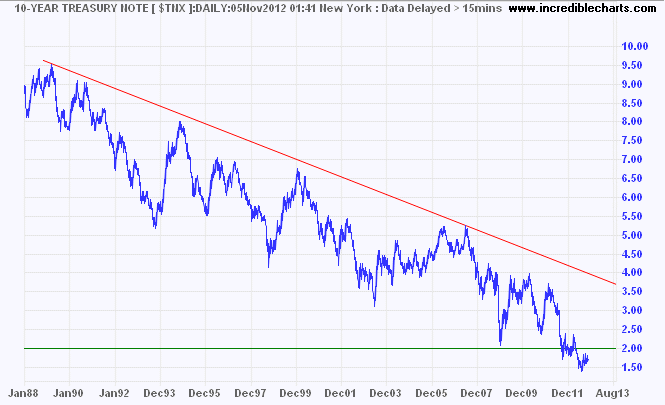Treasury yields warn more of the same
By Colin Twiggs
November 5th, 2012 3:00 a.m. ET (6:00 p:m AET)
These extracts from my trading diary are for educational purposes. Any advice contained therein is provided for the general information of readers and does not have regard to any particular person's investment objectives, financial situation or needs and must not be construed as advice to buy, sell, hold or otherwise deal with any securities or other investments. Accordingly, no reader should act on the basis of any information contained therein without first having consulted a suitably qualified financial advisor. Full terms and conditions can be found at Terms of Use.
Inflation has fallen over the last quarter-century, so one would expect to find Treasury yields have fallen, but there is more than just benign inflation at work. The Fed has also been suppressing long-term interest rates, with QE1, QE2, Operation Twist and now QE3.

The yield on 10-year Treasuries is now below the Fed's long-term inflation target of 2 percent, offering savers a negative return on investment unless they are prepared to take on risk. The Fed's aim is to induce investors to take on more risk, in the hope that increased capital spending will stimulate employment and lead to a recovery. But they risk leading savers into another disaster, with falling earnings or rising yields ending in capital losses.
Corporations are reluctant to expand and will remain so until they see a sustainable increase in consumption. Fueled by new jobs — not short-term credit. Low interest rates without job growth could cause another speculative bubble, with too much money chasing too few opportunities.
Without jobs, no monetary policy is likely to succeed.
More....
Dullness in matters of government is a good sign, and not a bad one — in particular, dullness in parliamentary government is a test of its excellence, an indication of its success.
~ Walter Bagehot

Author: Colin Twiggs is a former investment banker with almost 40 years of experience in financial markets. He co-founded Incredible Charts and writes the popular Trading Diary and Patient Investor newsletters.
Using a top-down approach, Colin identifies key macro trends in the global economy before evaluating selected opportunities using a combination of fundamental and technical analysis.
Focusing on interest rates and financial market liquidity as primary drivers of the economic cycle, he warned of the 2008/2009 and 2020 bear markets well ahead of actual events.
He founded PVT Capital (AFSL No. 546090) in May 2023, which offers investment strategy and advice to wholesale clients.
